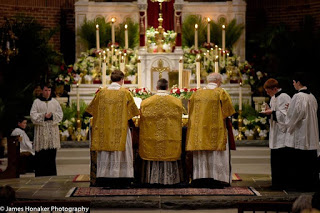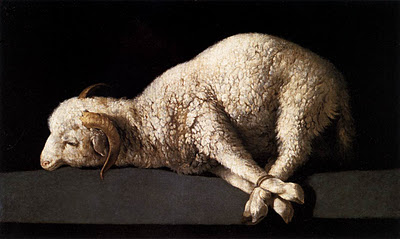Turning Toward God: Celebrating the Mass Ad Orientem, A Letter from Bishop James S. Wall

Pan-Amazon Pandemonium. by William Kilpatrick
July 23, 2019
U.S. Bishop Calls on Brother Bishops, Laity to Support Church’s Moral Teaching, by Lisa Bourne
July 23, 2019
A Letter from Bishop James S. Wall, Bishop of Gallup, New Mexico
Celebrating Mass Ad Orientem, Ad Deum, and Versus Populum
My dear friends in Christ:
Recently Pope Emeritus Benedict XVI released a powerful letter, in which he touched on a number of topics, including especially the sexual abuse crisis that has impacted the Church and even society as a whole. In his letter, he also addressed the Eucharist. He acknowledged, and rightfully so, that we have become too lax in our approach to the Eucharist. There were a number of reasons for this, even extreme cases when Holy Communion has been distributed to non-Catholics at weddings and other large events for the sake of “inclusion.” We know, however, that such “inclusivity” is actually quite dangerous, for it can put someone’s soul at risk in the name of not hurting feelings. Remember St. Paul: “Whoever, therefore, eats the bread or drinks the cup of the Lord in an unworthy manner will be guilty of profaning the body and blood of the Lord. Let a man examine himself, and so eat of the bread and drink of the cup. For anyone who eats and drinks without discerning the body eats and drinks judgment upon himself” (1 Cor. 11:27-29). We would do well to remember, then, that the Eucharist is not simply a nice “sign” or “symbol” of communion with God, but rather truly is communion with God. (In fact, it is so far from being a mere symbol in the modern sense of that term, that Flannery O’Connor once famously said that “if it is just a symbol, to hell with it!) For the Eucharist is nothing less than the very Body, Blood, Soul, and Divinity of Jesus Christ, and the “source and summit of the Christian life” (Lumen gentium, 11).
Pope Benedict’s letter thus provides an opportunity for us to reflect on how better to respect the Most Blessed Sacrament of the Eucharist. There are of course many ways to do this: arriving early to prepare for Mass in prayer; staying after to offer an Act of Thanksgiving; dressing appropriately at Mass and in Church (“Sunday best” is still a thing!); keeping the one-hour Eucharistic fast; making regular (even monthly) sacramental confession; and reverently, not hurriedly, receiving Holy Communion readily come to mind (cf. Catechism of the Catholic Church, 1385-1389). There is, however, one particular practice that I would like to highlight here. It is about exercising the option to celebrate the Holy Sacrifice of the Mass facing “toward the East” (ad orientem) or “toward God” (ad Deum) as distinct from “toward the people” (versus populum).
Let me say at the outset: I know this can be a contentious topic. To make changes to the way we pray can be difficult, especially when it comes to liturgical prayer. By explaining and advocating for this, I am in no way trying to disrupt the way the people of this Diocese pray. Rather, I am trying to open the treasury of the Church’s patrimony, so that, together, we can all experience one of the most ancient ways that the Church has always prayed, starting with Jesus and reaching even to our own day, and thereby learn from the “ever ancient, ever new” wisdom of the Church.
With that in mind, let me start with just a brief historical note. Essentially, we can say that celebrating Mass ad orientem is one of the most ancient and most consistent practices in the life of the Church—it is part of how the Church has always understood the proper worship of God. Uwe Michael Lang has published a book showing just this, entitled Turning Towards the Lord: Orientation in Liturgical Prayerand published by Ignatius Press. His extensive and thorough research shows this very fact: that, in the words of Cardinal Ratzinger, “Despite all the variations in practice that have taken place far into the second millennium, one thing has remained clear for the whole of Christendom: praying toward the east is a tradition that goes back to the beginning” (The Spirit of the Liturgy, p. 75). This means that celebration of Mass ad orientem is not a form of antiquarianism, i.e. choosing to do something because it is old, but rather choosing to do something that has always been. This also means, in turn, thatversus populum worship is extremely new in the life of the Church, and, while a valid liturgical option today, it still must be considered novel when it comes to the celebration of Mass.
Allow me now to give a brief explanation of ad orientem or ad Deum worship. Prayer and worship “toward the East” (ad orientem, oriented prayer) “is, first and foremost, a simple expression of looking to Christ as the meeting place between God and man. It expresses the basic christological form of our prayer. […] Praying toward the east means going to meet the coming Christ. The liturgy, turned toward the East, effects entry, so to speak, into the procession of history toward the future, the New Heaven and the New Earth, which we encounter in Christ” (Joseph Ratzinger, The Spirit of the Liturgy, p. 69-70). By facing Christ together at Mass, we can see how “[o]ur prayer is thus inserted into the procession of the nations to God” (ibid., p. 76).
Ad orientem worship is thus a very powerful reminder of what we are about at Mass: meeting Christ Who comes to meet us. Practically speaking, this means that things will look a bit different, for at such Masses the Priest faces the same direction as the Assembly when he is at the altar. More specifically, when addressing God, such as during the orations and Eucharistic Prayer, he faces the same direction as the people, that is, toward God (ad Deum). He does so literally, to use a phrase dear to St. Augustine, by “turning toward the Lord” present in the Blessed Sacrament. In contrast, when addressing the people, he turns to face them (versus populum).
Some of you may be familiar with this, and perhaps have even been at Masses celebrated this way. The common way of describing such Masses is usually to say, by way of objection, that “the priest has his back to the people.” Now, while this is technically true, it largely misses the main point, which is one much grander and more beautiful: ad orientem worship shows, even in its literal orientation, that the priest and the people are united together as one in worshipping God, even physically with their bodies, “in a common act of trinitarian worship…. Where priest and people together face the same way, what we have is a cosmic orientation and also an interpretation of the Eucharist in terms of resurrection and trinitarian theology. Hence it is also an interpretation in terms of Parousia [end of the world], a theology of hope, in which every Mass is an approach to the return of Christ” (Joseph Ratzinger, Feast of Faith, p. 140). Celebrating Mass ad orientem, then, is meant to remind us of all these important factors of our faith, and, ultimately, that the Mass is not first and foremost about us, but rather about God and His glory—about worshipping Him as He desires and not as we think best. It is His work after all, not ours, and we are simply entering into it by His gracious will. In 2007, Pope Benedict spoke of just this fact in his address to the monks of Heiligenkreuz Abbey in Vienna:
“In all our efforts on behalf of the liturgy, the determining factor must always be our looking to God. We stand before God—he speaks to us and we speak to him. Whenever in our thinking we are only concerned about making the liturgy attractive, interesting and beautiful, the battle is already lost. Either it is Opus Dei [the work of God], with God as its specific subject, or it is not. In the light of this, I ask you to celebrate the sacred liturgy with your gaze fixed on God within the communion of saints, the living Church of every time and place, so that it will truly be an expression of the sublime beauty of the God who has called men and women to be his friends!”




